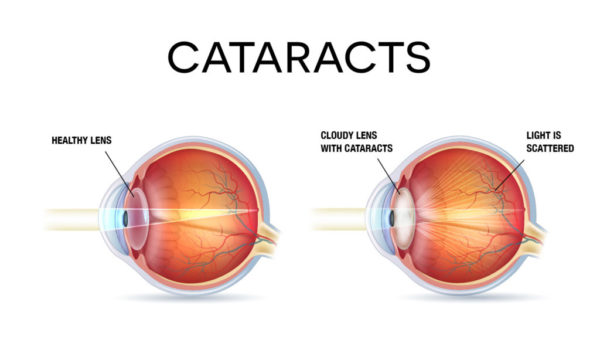Project Description
Cataract
Cataract is the clouding of the eye’s natural lens. It is the most common cause of vision loss in people over age 40 and is also the principal cause of blindness in the world. Types of cataracts include: A subcapsular cataract occurs at the back of the lens.

Types of cataracts
- A subcapsular cataract occurs at the back of the lens. People with diabetes or those taking high doses of steroid medications have a greater risk of developing a subcapsular cataract.
- A nuclear cataract forms deep in the central zone (nucleus) of the lens. Nuclear cataracts usually are associated with aging.
- A cortical cataract is characterized by white, wedge-like opacities that start in the periphery of the lens and work their way to the center in a spoke-like fashion. This type of cataract occurs in the lens cortex, which is the part of the lens that surrounds the central nucleus.
Cataract symptoms and signs
Cataract treatment
Postoperative Cataract surgery care
- Postoperative Cataract surgery care
- Eye Protection
After surgery,use a protective plastic shield for 2 to 3 weeks to protect the eye and prevent any impact to the eye. You can use glasses during the day. The plastic shield is washable. Rinse it daily with soap and water and then put it on your eyes.
- Avoid rubbing and pressing your eyes.
- Mild postoperative pain can be reduced by acetaminophen prescribed by the physician.
- Travel after surgery
Traveling with car, train and plane is allowed after the surgery.
- Praying
From the day of operation, praying with tayammum is only allowed on the stone. However, do your prayers in a sittingposition up to one week and avoid prostration and approach the Turbah with hand to your forehead.
- The activities limitation depends on the type of surgery.
- After the surgery, sleep on your back. Do not sleep by the side of the eye that is operated and avoid sleeping in the prone position.
- Avoid coughing, sneezing, sudden and intense shaking of the head and do not push when defecating.
- Avoid doing hard work and lifting heavy objects after the operation.
- Study, watching television and usual activities of life not associated with intense physical activity are allowed.
- Postoperative Bathing
Ask your doctor for bath time or you can get a bath after the fifth day by your doctor’s advice. But keep the eyes closed when washing your head and face and do not put pressure on the eyelids at all.It is better to use a baby shampoo.
- Diet
On the night of the operation day, a light diet (soups and vegetables) and liquids is preferable to use. If you have a specific diet, continue the same diet after the surgery.Prevent constipation by eating the right amount of vegetables, fruits and water.
- Taking previous medication
Continue your previous medications according to the previous procedure. Consult with your doctor about taking ASA (aspirin) and anticoagulants (warfarin).
- Use of cosmetics
Strongly avoid the use of cosmetics (mascara, synthetic eyelashes, colored lenses, oily materials, etc. around the eyes) and ask your doctor when you can begin again to use them.
Ask your doctor for the time to start driving, using the pool and hair coloring.
- Glasses
If the cataract surgery with a lens is successful, you will need a near vision glasses to do close tasks and study after the surgery, which should be consulted with the doctor.It is worth mentioning that sometimes you need glasses for the far sight as well.
- Correct use of eye drops
First, wash your hands thoroughly with soap and water. Bend your head slightly back, pull your lower eyelid down with your pointer finger to create a small hole. Drop a droplet in the created hole. Avoid the contact of the dropper with hands or the edges of the eyelids. After dropping the drop, keep your eyes gently closed for two to three minutes. This will help to better absorb of the medicine and reduce its effects. If you need to use two different drops at a time, make an interval of at least five minutes between them. At intervals of sleep (5-6 hours), you do not need to wake up for using the drops. In your medication (eye drop)finished before your doctor appointment and before completing the course of treatment, you can recycle it from the pharmacy.
- After opening the eye drop lid, you should throw it away three weeks to one month later.
- If your eyelids stuck together, drop a few drops of chloramphenicol (CHLOBIOTIC) on them and clean the softened secretions with a sterilized gauze (a sterile lace-like texture that you can get from the pharmacy) without making any pressure to the eyeball.
- Take your ophthalmic medicines every time you visit your doctor.
- Natural symptoms
The ocular symptoms that are mentioned are not normal and not concerning: Mild redness, mild runny eye, mild blurred vision, foreign body sensation and short eyelid dropping.These symptoms gradually disappear within 4 to 6 weeks after the surgery.
- Attention to abnormal eye symptoms
In general, we expect blurred vision and eye discomfort in the post-operative days tend to recovery. But in case of worsening or confrontation with symptoms such as permanent pain, persistent sensitivity, increasing redness, decreasing visibility, severe nausea and vomiting, pussy secretions, severe irritation in the days after surgery, immediately visit your doctor.If you do not have access to your doctor, you can go to the Eye Hospital (Farabi, Labafi-Nezhad, Torfeh, etc.).

